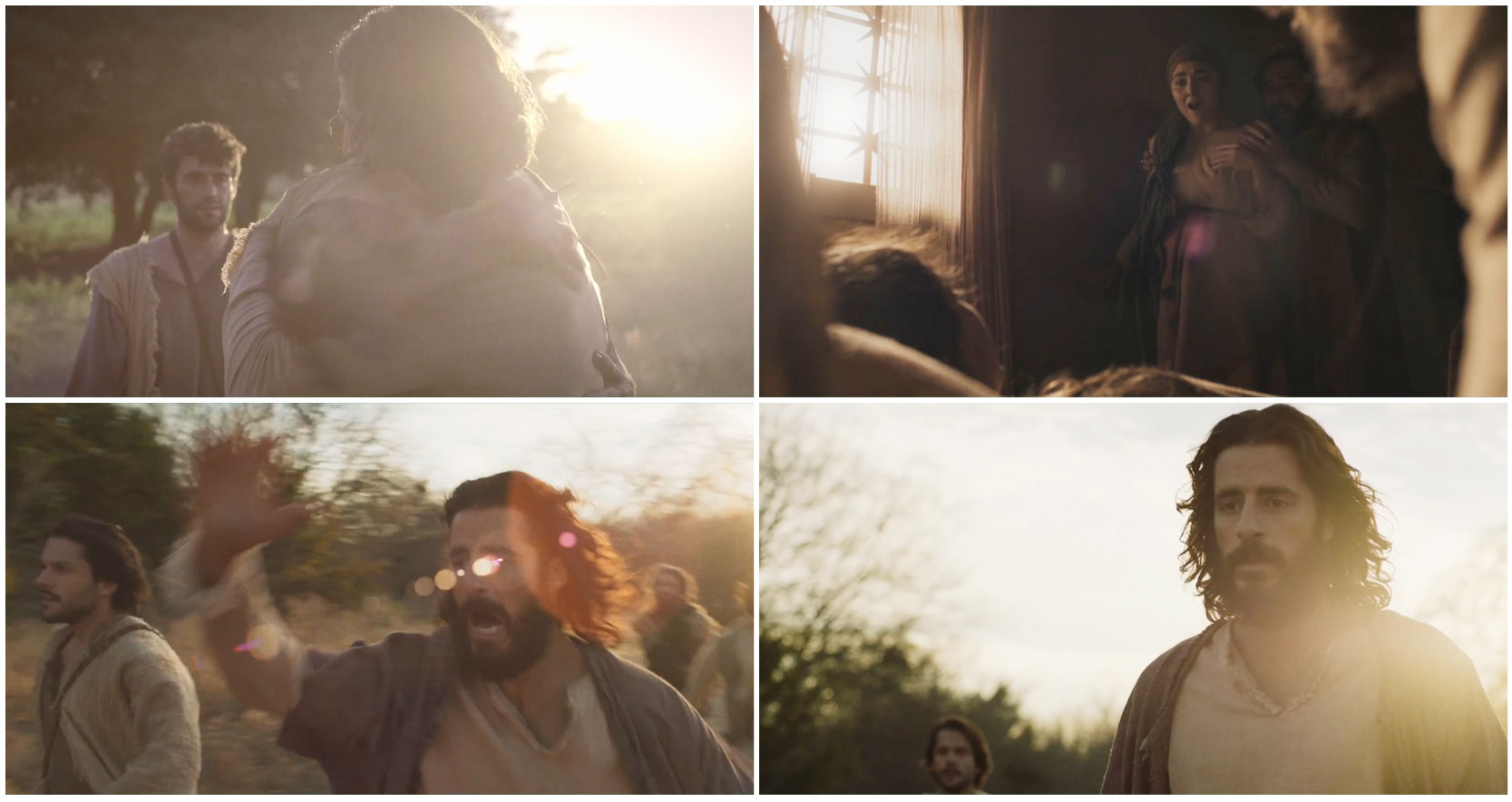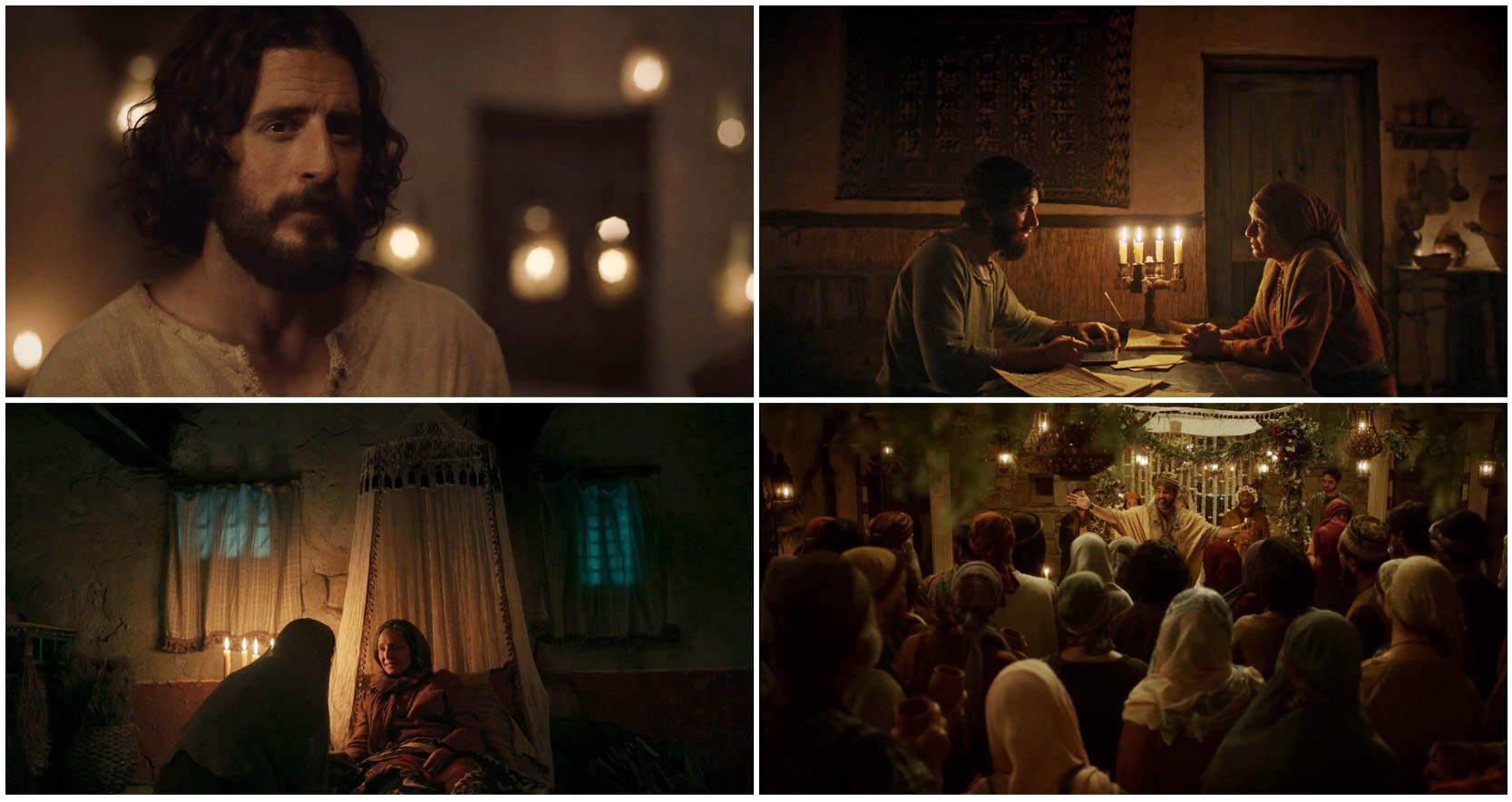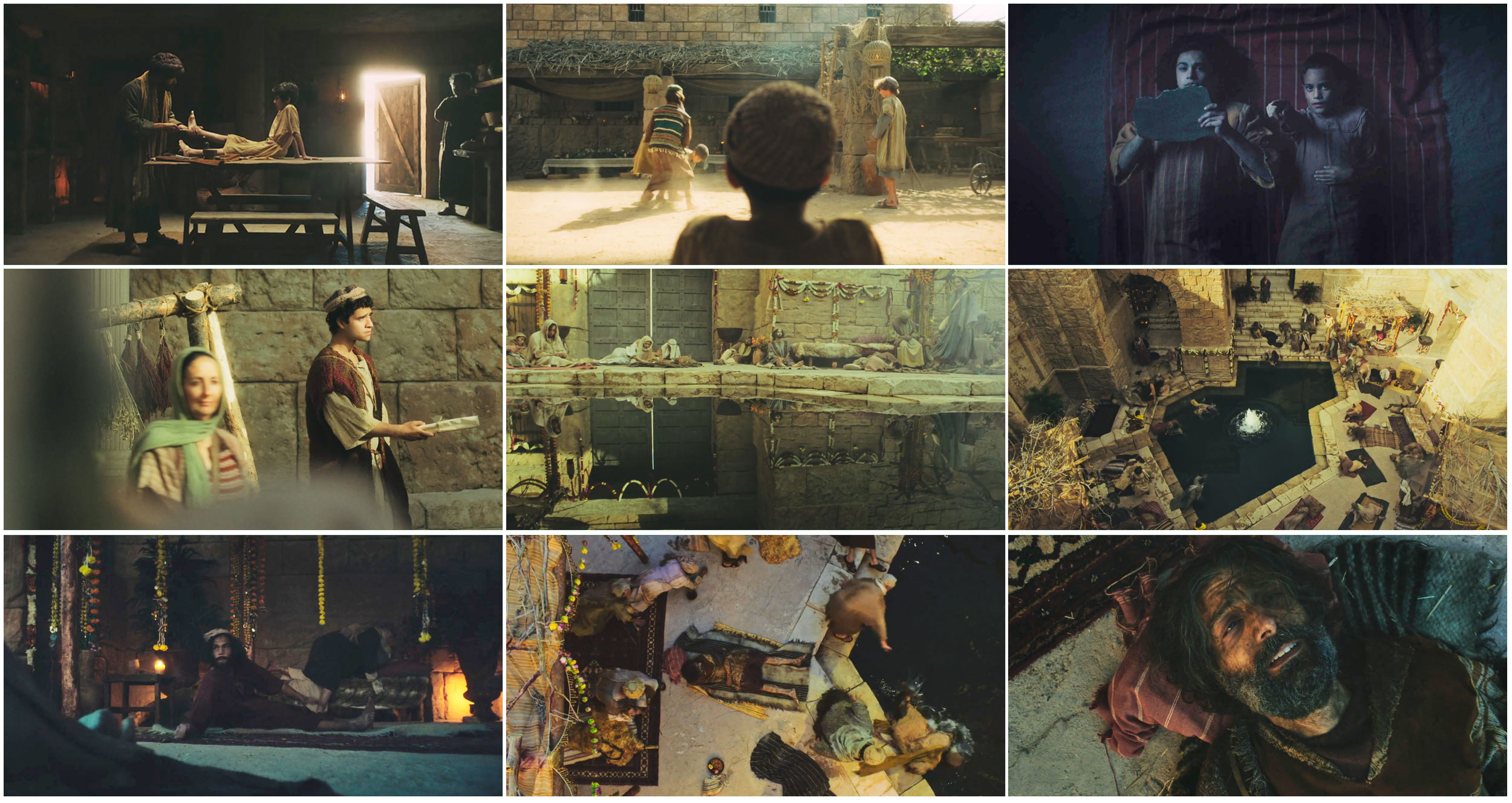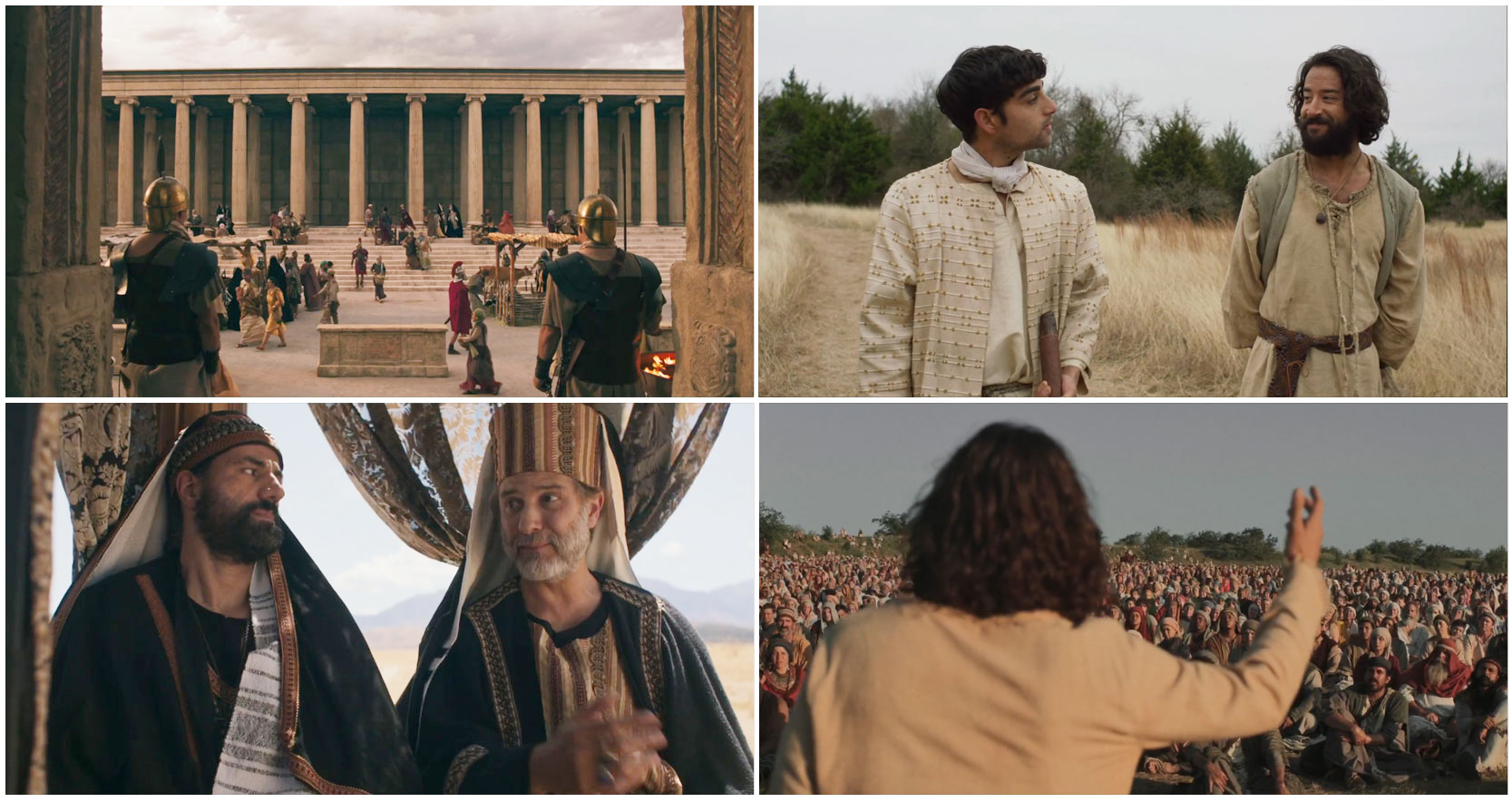At the time of this writing, The Chosen is the highest ever crowdfunded project in television and film. With creator Dallas Jenkins at the helm, the show has raised over $40 million for its first three seasons including $18 million for Season 3 alone. That may sound like a lot of money, but compare it to the cost of Netflix's Stranger Things final Season 4 at $270 million (roughly $30 million per episode) or Season 1 of Amazon's The Lord of the Rings: The Rings of Power on which they spent an astonishing $715 million (including a production budget of about $58 million per episode). In this age of "Peak TV," how does the production quality of The Chosen measure up?
I binged Seasons 1-3 last July, and overall, I'm impressed by the richly textured world that Jenkins and his team have created. I've selected several images from the series that represent notable achievements in production quality and art direction, and I've described how I believe these visual choices heighten our emotional experience and connection to the story.
Cinematography
"The human eye is drawn to light," says Jesus to Nicodemus in Season 1 Episode 6. As you would expect from a show that begins in AD 26, its lighting design relies on the manipulation of natural light (or the appearance thereof), candlelight, and other sources of flame. Whether pouring through a window, across a city street, or over the open sea, the natural light is often soft and gold. It catches dust and smoke, reflects on the water's surface, and is aided by warm color grading that works nicely with the show's predominant focus on people.

Particular attention is given to the lighting of Jesus during key moments of his ministry. The images below represent three miracles (healing a leper, raising Jairus's daughter, and exorcising a demon). These scenes are all dramatically backlit from the sun. This heavenly glow connects Jesus's miraculous acts to his divine nature and heightens our sense of awe, a feeling usually reflected onscreen in the faces of his witnesses.

When the sun goes down, the scenes twinkle with light from candles, torches, or campfires. This is done well throughout the series — many of the screenshots below could be baroque paintings.

Another important aspect of cinematography is framing. From the outset, The Chosen is exquisitely composed. Framing and lighting work together in the shots below to depict one of my favorite visual motifs of the series: the sense that, without Jesus, the characters are trapped behind bars (literal and figural). Narratively, these people are struggling with their demons, debts, professional obligations, and failures. These poetic images reinforce those plot points beautifully.

The angle of the camera is also used wisely. In the top row of images below we see Jesus awakening to a group of children visiting his camp. This is one of our first encounters with Jesus onscreen, and this point-of-view shot looking up at the children emphasizes his humility and nature as True Man. In the bottom left, Jesus has been rejected by his home town and taken to a cliff. The framing of this shot intensifies the conflict by making Jesus look trapped and vulnerable to larger, more formidable adversaries. In the bottom right, a lame man is brought to Jesus. The camera pans back to reveal his feet as the center and focus of the shot, where the miracle is indicated by the wiggling of his foregrounded toes.

This camera pan is one of many effective and varied camera movements throughout the series. Political and personal conversations are often accompanied by a handheld camera that gives a strong sense of immediacy to the discussions. Slower pans accompany more philosophical or intense scenes, which engages the viewer differently (and often without conscious awareness).
I will also highlight some moments in which the filmmakers shoot at a high frame rate to achieve a "slow motion" effect. This technique is employed when Jesus walks past a number of crucified men, when he is forcibly removed from the temple in Nazareth, and when Nicodemus is reeling after a miracle. Slow motion allows the viewer to penetrate the minds of these characters and feel the gravity of each situation more deeply.
Editing
As in most series, continuity editing is predominant. That being said, one of the things I love about television is that it allows writers and showrunners to play with format and experiment with novel ways of storytelling. One of the ways this is done on The Chosen is with montages in the cold opens (the first scene of each episode that plays before the titles). For example, Season 3 Episode 4 begins with a montage set entirely in black and white. This signals a departure in the narrative as Jesus's disciples have been sent away in pairs to spread his message and perform miracles on his behalf. Black and white images have a timeless and dramatic quality that accentuates differences in value (brightness/darkness) and consequently emphasizes lighting. And though it's not captured in the extraordinary stills below, camera moves and sound design contribute to the art direction by further connecting the missions in these disparate locations.

I've selected another montage from Season 2 Episode 4, in which the cold open tells the (non-Biblical, but plausible) story of Simon the Zealot and his crippled brother. Several decades are covered in this sprawling tale that includes the brothers' painful childhood, Simon's choice to join the Zealots, his training, and his brother's move to the pool of Bethesda. It's an ambitious story made easy to follow in a montage that includes match cuts and rhythmic editing. The shot types and compositions are varied, the camera moves are alluring, and the images are distinct and moving. This montage quickly builds the viewer's understanding of and connection to Simon ("Zee"), which is both difficult and imperative as new characters are added to an already large cast.

Another way The Chosen occasionally defies convention is with long takes. The longest appears in Season 2 Episode 3, a unique episode in that there is no cold open. The episode's first scene is a 15-minute-take that follows a number of disciples as they walk back to camp and discuss the day's events. This storytelling strategy captures a slice of life as Jesus's followers attempt to make sense of his ministry, their new lives and stresses on the road, and their relationships with one other.
Set Design & Costumes
"I don't like your frock," says John the Baptist to Nicodemus in Season 1 Episode 5. "The cost of the vestments alone could feed three children in Nazareth for a month." I honestly have no idea what the terrain, costumes, or sets should look like during this time period. But from a storytelling perspective, The Chosen uses its funding well. The costumes make it abundantly clear who works for Rome, who works in the synagogues, who has money, and who does not. They help us recognize different cultures, follow political machinations, and internalize identities in a way that's easier for many than reading the Biblical texts on which it's all based.

When the series begins in Capernaum, shots are infrequently wide and sets are rarely sizable. It feels small, condensed, even a bit claustrophobic in the dense city streets and interiors. The focus is not on establishing a vast world, but rather on the people that occupy the screen. As Jesus becomes a larger presence on the show, the shots "breathe" quite a bit more and the action progresses to locations that are more impressive in scope. When Jesus feeds the 5,000 in the Season 3 finale, it's a real spectacle.
Though the sets and costumes are skillfully done, it continually bothers me that the characters are not speaking Aramaic. I recognize that I have a higher tolerance than many for subtitles and the choice to use English prioritizes accessibility. But for this reason, I could never truly suspend my disbelief.
Visual Effects
In terms of effects, this isn't an especially flashy show by today's standards. There's some minor VFX associated with miracles, a few matte paintings of important locations, and a longer sequence in which Jesus walks on water and calms the storm in the Season 3 finale. I found the quality of these effects to be respectable, and I appreciate the subtlety in the mechanics of the miracles generally. It wouldn't feel right to see the loaves and fish multiplying supernaturally onscreen, rather, Jenkins directs our attention to the characters' reactions.
Sound Design
The scoring blends middle eastern music with more contemporary styles and spirituals. It's consistently appropriate and emotionally resonant (in film, the sound tells you how to feel). Some of my favorite moments involve strong, rhythmic pulses leading up to a perfectly-placed moment of silence. The mixing is also well-done throughout. When Jesus is preaching to a crowd of thousands, I love how you can hear his disciples repeating his message to further groups.
Final Thoughts
During a time in which we've seen unprecedented growth in the cost and quality of television, The Chosen as a whole is at times breathtaking and flat, clever and tedious. Its inconsistency is typical of the medium (no series is perfect) and shouldn't diminish its achievements as a one-of-a-kind series that makes biblical content relevant in today's world. They have done amazing things with a modest budget, and the structure of each season will likely improve with time and practice. I'm most excited about The Chosen as a proof of concept. Now that demand and feasibility have been established, can you imagine a highly-produced and sharply written series that chronicles the epic battles and miracles of the Old Testament? This could be must-see television not only for Christians but for everyone currently tuning into HBO’s Sunday night showpiece.
Images used with permission.
Return to original language with "show original" button at top left.

Discussion
My film class has been talking about different aspects of cinematography, and I appreciated your analysis and application of different techniques such as lighting, framing, and camera movement to "The Chosen." One particular aspect you discussed that I found the most interesting was your review of the set design. I specifically liked your quote where you said, “It feels small and condensed, even a bit claustrophobic in the dense city streets and interiors. The focus is not on establishing a vast world, but rather on the people that occupy the screen.” This quote stuck with me because as I watched the early episodes of the show, I definitely felt the sense of being claustrophobic. Your analysis helped explain to me why the creators would choose to present this feeling until Jesus makes his eventual appearance.
My knowledge of the purpose for choices in editing is limited; however, after reading your analysis, I was left with a question regarding a change of opening in episodes that you briefly mentioned. You said that "The Chosen" makes a novel way of storytelling through their montages in cold openings, then later, you discussed a unique episode where the cold open is omitted and replaced with a long shot duration. I understand the purpose of the long take and what they are trying to convey with that approach. My question is, however, what is the purpose of getting rid of the cold open? Is the purpose to solely change it up a bit? My thought would be that they could keep the cold open that they are accustomed to and then have the long take to reach the same effect, but I may also be missing the point of its omission.
Thank you for the time you gave in your analysis of the production value of The Chosen. I feel like it gave me a better understanding of the choices made during filming and editing, as well as gave me new ideas about the purpose of these choices.
While taking a Film and Mass Media Class at Martin Luther College, I have become somewhat of a self-proclaimed movie nerd. I am fascinated by the decisions directors choose to make regarding music, light, angles, proximity, and many other cinematography choices throughout a film. I truly appreciated the amount of insightful observations you made about The Chosen. I was especially intrigued by your section on set design. When talking with a classmate, we did discuss how small and claustrophobic the scenes felt. Neither of us has seen more than three episodes of the show, so we have not yet experienced the entire shift in feeling. I found your point about Jesus’ presence to be so interesting. The more Jesus is present, the more of the world we are able to see. The show provides us with the opportunity, whether we recognize it or not, to retreat into our own little closed-off world. Through the presence of Jesus, we find the ability to breathe amidst the chaos and evil that surrounds us.
Continuing my previous point, I was wondering if you had any thoughts about the logistics of widening what we, as the viewers, are able to physically see. A classmate and I debated whether or not this was a planned design that was engineered to make us feel this dramatic shift when Jesus was around or was it simply a budgeting decision since funds for the project were initially limited and grew with time. I am interested in hearing your thoughts.
I want to thank you for your thoughtful insights and observations about the production of The Chosen. Your expertise on these topics really piqued my interest and allowed me to think deeper about the impact the show has had on my understanding of the life of Jesus.
As a first-year Media Arts student at Bethany, I've been trying to learn as much as I can and am very interested in both the technical and creative details that go into making a production look good and entertaining for the viewer. Reading about all the ways that they use things like lighting, framing or set design was very interesting, especially when creating something that took place two thousand years ago. The creative ways of using all these different aspects to put a show together were all very interesting to read and learn more about. I haven't seen the show yet, but after reading this I might take the time to watch it.
Thank you for taking the time to write about what goes into making a show like The Chosen, and making it look as good as it does. It was very interesting to learn more about the production that goes into a series. It's always interesting to hear new ways technology is being used for getting the Bible out there into the world.
I am currently taking the class Film and Mass Media at Martin Luther College, and I was excited to see all the terms and techniques we have been studying applied to The Chosen. I especially was interested in your notice of the visual motif of bars. I enjoyed your take on the symbolic notion of being trapped without Christ. This is something I will look for as I continue to watch the series.
In your article, you mentioned that the sets and costumes place a viewer into the world of ancient Israel. I agree with the power the program has in this way, but I also wondered if that immersive realism could cause viewers not familiar with the Bible to lean on the show as the authority for the stories and era portrayed? I am wary about basing my geographical, cultural, and Biblical knowledge on the storytelling of a medium designed to entertain. This type of immersion certainly is able to make parts of scripture more accessible to many and provide high-quality entertainment to all, and I appreciate the in-depth storytelling and the effort of creating an immersive world, but I find myself comparing what I see on the screen to what I have learned from my Biblical studies.
Thank you for the time and energy you have devoted to studying this series. I enjoyed reading your article and growing my knowledge of cinema through it. I am looking forward to seeing the film-making techniques you highlighted being utilized as I continue watching the show.
I am currently taking a film college course to learn more about how film techniques help emphasize the movie and its message. The course has taught me much about how camera movement and lighting affect how the viewer perceives a scene. Your article helped highlight many of those points, especially concerning the lighting used in the series, which I truly appreciate! It helped me recognize the significance of each scene and moment.
While reading your article, I was perplexed by one sentence, and I hope you can clarify it for me. I was reading about your insight into the costumes and terrain of The Chosen, which helped me focus on how each element is used. However, you mention how “it continually bothers me that the characters are not speaking Aramaic” under the section where you talk about costumes. I wondered why it mattered so much to you that the characters should speak Aramaic. I do not mean that in a condescending way. A more clarifying question would be: does speaking English remove a certain element that would have helped the series? I have always viewed language as something that does not affect how a film or TV series is portrayed. I am just curious about a further explanation of this viewpoint.
Thank you for this opportunity to explore The Chosen more deeply. I greatly appreciate the time and energy you have put into this work. May God bless you!
Though I am likely in the minority on this one, I would challenge your view that language is unimportant in film. In film and TV, many important plot points and character notes involve language!